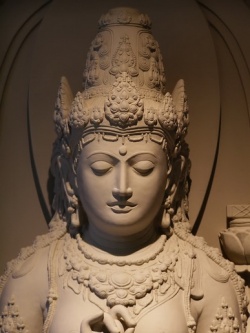Difference between revisions of "Lalitavistara"
(Created page with "thumb|250px| The Lalitavistara,The Description of the (Buddha’s) Play,is an early biography of the Buddha composed in Sanskrit prose and verse in 27 ch...") |
|||
| Line 1: | Line 1: | ||
[[File:Amitabha.JPG|thumb|250px|]] | [[File:Amitabha.JPG|thumb|250px|]] | ||
| − | The Lalitavistara,The Description of the ( | + | <poem> |
| + | The Lalitavistara,The Description of the ([[Buddha]]’s) Play,is an early biography of [[The Buddha]] composed in [[Sanskrit]] prose and verse in 27 chapters. It seems to be a reworking of an earlier account of [[The Buddha]]’s [[Life]] and its earliest sections may date from about the 1st century BCE, although other sections were still being added as late as the 3rd century CE. The Lalitavistara contains all the main incidents in [[The Buddha’s biography]] but surrounds them with the most overblown and exaggerations details. [[The Buddha]] is depicted as a [[God]] above the [[Gods]], always accompanied by a retinue of thousands and performing the most amazing [[Miracles]]. In this sense it marks the [[Beginning]] of a trend that led to the complete [[Divorce]] of [[The Buddha]] from historical reality and his eventual deification. The Lalitavistara was enormously popular in [[India]] and beyond and was translated into numerous languages. The sides of all the lower terraces on the great temple of [[Borobudur]] have hundreds of carved panels on them depicting scenes from the Lalitavistara. | ||
| + | |||
| + | The Lalitavistara Sutra (English: Extensive Sport Sutra) is a Mahayana Buddhist Vaipulya sutra that describes the sports (lila) of Gautama Buddha. It is a compilation of various works by no single author and includes some material from the Sarvastivada school. The scholar P. L. Vaidya dates the finished Sanskrit text to the 3rd century. | ||
| + | [[File:E011.jpg|thumb|250px|]] | ||
| + | Borobodur | ||
| + | |||
| + | The Lalitavistara Sutra was known to the Mantranaya stonemasons of Borobodur, refer: The birth of Buddha (Lalitavistara). 'Mantranaya' is not a corruption or misspelling of 'mantrayana' even though it is largely synonymous. Mantranaya is the term for the esoteric tradition on mantra, a particular lineage of Vajrayana, in Indonesia. The clearly Sanskrit sounding 'Mantranaya' is evident in Old Javanese tantric literature, particularly as documented in the oldest esoteric Buddhist tantric text in Old Javanese, the Sang Kyang Kamahayanan Mantranaya refer Kazuko Ishii (1992). | ||
| + | |||
| + | The Lalitavistara Sutra is nothing less than the auto-biography of Buddha. It includes a description of his enlightenment. It is published by Dharma Publishing in Berkeley under the title "Voice of the Buddha: The Beauty of Compassion," as a 2 vol. set. | ||
| + | Numerals | ||
| + | |||
| + | In the Lalitavistara the Buddha explains to a mathematician named Arjuna the system of numerals in multiples of 100, starting from a koti (in later literature 10^7 but this is uncertain) to a tallakshana (10^53 then). | ||
| + | </poem> | ||
{{R}} | {{R}} | ||
[http://www.buddhisma2z.com/content.php?id=219 www.buddhisma2z.com] | [http://www.buddhisma2z.com/content.php?id=219 www.buddhisma2z.com] | ||
[[Category:Buddhist Terms]] | [[Category:Buddhist Terms]] | ||
[[Category:Sutras]] | [[Category:Sutras]] | ||
Revision as of 15:58, 16 May 2013
The Lalitavistara,The Description of the (Buddha’s) Play,is an early biography of The Buddha composed in Sanskrit prose and verse in 27 chapters. It seems to be a reworking of an earlier account of The Buddha’s Life and its earliest sections may date from about the 1st century BCE, although other sections were still being added as late as the 3rd century CE. The Lalitavistara contains all the main incidents in The Buddha’s biography but surrounds them with the most overblown and exaggerations details. The Buddha is depicted as a God above the Gods, always accompanied by a retinue of thousands and performing the most amazing Miracles. In this sense it marks the Beginning of a trend that led to the complete Divorce of The Buddha from historical reality and his eventual deification. The Lalitavistara was enormously popular in India and beyond and was translated into numerous languages. The sides of all the lower terraces on the great temple of Borobudur have hundreds of carved panels on them depicting scenes from the Lalitavistara.
The Lalitavistara Sutra (English: Extensive Sport Sutra) is a Mahayana Buddhist Vaipulya sutra that describes the sports (lila) of Gautama Buddha. It is a compilation of various works by no single author and includes some material from the Sarvastivada school. The scholar P. L. Vaidya dates the finished Sanskrit text to the 3rd century.
Borobodur
The Lalitavistara Sutra was known to the Mantranaya stonemasons of Borobodur, refer: The birth of Buddha (Lalitavistara). 'Mantranaya' is not a corruption or misspelling of 'mantrayana' even though it is largely synonymous. Mantranaya is the term for the esoteric tradition on mantra, a particular lineage of Vajrayana, in Indonesia. The clearly Sanskrit sounding 'Mantranaya' is evident in Old Javanese tantric literature, particularly as documented in the oldest esoteric Buddhist tantric text in Old Javanese, the Sang Kyang Kamahayanan Mantranaya refer Kazuko Ishii (1992).
The Lalitavistara Sutra is nothing less than the auto-biography of Buddha. It includes a description of his enlightenment. It is published by Dharma Publishing in Berkeley under the title "Voice of the Buddha: The Beauty of Compassion," as a 2 vol. set.
Numerals
In the Lalitavistara the Buddha explains to a mathematician named Arjuna the system of numerals in multiples of 100, starting from a koti (in later literature 10^7 but this is uncertain) to a tallakshana (10^53 then).

